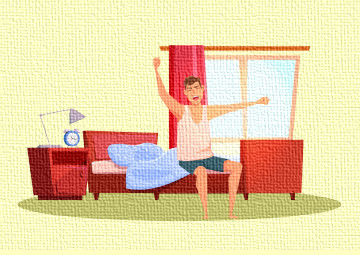Fall asleep faster with these 5 proven methods
Sleep disturbances are more prevalent nowadays than ever before. We observe sleep problems in
people across various age groups. No wonder why we've come to relate to this phenomenon as a 'silent
epidemic'. 2021 UK sleep statistics reveal that "36% of UK adults struggle to get to sleep
at least on a weekly basis [and] nearly half of the UK have trouble falling asleep at
least once a month."[1]
We tend to underestimate the importance of sleep and how badly lack of it affects our physical and
mental well-being. We've increased the pace of our lives, leaving little room for relaxation and
'decompression' from daily stresses. We rush through days ticking off one task after another, being
in a round-the-clock hurry. Whilst there is nothing wrong with leading a busy life, we tend to
forget to 'switch off', continuing to worry about the next task to come or reminiscing on day
events,
long after the day is over. This kind of mental arousal, particularly close to bedtime, may result
in poor sleep quality or difficulty falling/staying asleep. If you struggle with those symptoms
regularly and find that they persist for a long time, read this, as you might be suffering
from insomnia.
Let's take a look at some relaxation techniques and breathing exercises that might help you fall
asleep faster. Whilst, in certain cases, sleep disturbances may require a professional approach,
most
of the techniques explained below are commonly utilised as a part of CBT[2](Cognitive Behavioural Therapy), which is an effective way of
treating different mental health disorders or sleep problems.
Try these 5 methods to fall asleep faster:
-
1. Mindfulness meditation.
-
2. Four-Seven-Eight breathing.
-
1. Breathe in through the nose for 4 seconds.
-
2. Hold the breath for another 7 seconds.
-
3. For 8 seconds, with your lips pursed, exhale through the mouth, as if you were about to whistle.
-
4. Repeat this sequence up to 4 times.
-
3. Papworth method.
-
1. Sit or lie down comfortably.
-
2. Put one hand on your chest and one on your stomach and breathe in through your nose. You should feel your stomach rising while your chest remains relatively still.
-
3. Exhale through pursed lips.
-
4. Repeat a few times.
-
4. Paradoxical intention.
-
1. Lying in bed, try to keep your eyes open for as long as you can. Keep affirming yourself that you’re doing well and you just need to keep your eyes open for a little longer. Remember, the goal is to stay awake.
-
2. Don't let anxiety get in your way, stay focused on your task.
-
5. Progressive muscle relaxation.
-
1. Starting from your lower extremities, inhale and tense one muscle group at a time( for instance calves) for 5-10 seconds and release the tension as you exhale.
-
2. Rest for a few seconds and proceed with another muscle group( for example thighs), repeat the process.
-
3. Work your way up to your upper body, including facial muscles( tensing up cheeks, lifting up eyebrows etc.)
It describes the practice that focuses on being fully present in the given moment, being aware of your surroundings as well as sensations, thoughts and feelings whilst observing them with no judgment or emotional response. Through breathing exercises or/and visualisation it aims to help develop physical and mental awareness. Mindfulness meditation is about noticing your thoughts and feelings without identifying yourself with them or getting emotionally carried away. This method is very likely to help you relax your mind and body, helping you get into the 'sleep mode' faster. It is also known to reduce stress, anxious thoughts and improve focus. Here is how to meditate.[3]
4-7-8 breathing is a technique of mindful breathing that is based on pranayama yoga[4], the ancient yogic practice that focuses on the breath. This technique instructs to inhale for 4 seconds, hold the breath for 7 seconds and to exhale for 8 seconds. It is very likely to help you fall asleep within minutes. Wanna give it a go? Here's how to do it:
This breathing technique was developed in the 1960s and it emphasizes diaphragmatic breathing, or, in other words, abdominal breathing. This type of exercise strengthens your diaphragm, the large respiratory muscle located just below the lungs. Diaphragmatic breathing forms the basis of many meditation and relaxation practices but is also known for reducing symptoms of asthma.[5] Research also finds that it may help lower blood pressure[6] and heart rate[7], which results in stress reduction and therefore, promotes relaxation. Here are some basic tips for diaphragmatic breathing:
Refers to a cognitive method developed by psychologist Viktor Frankl. Paradoxical intention revolves around performance anxiety and suggests that fear or angst prevent falling asleep. As its name suggests, this technique is based on the idea of making an effort to stay awake for as long as possible rather than trying to go to sleep (hence the paradox). It forces individuals to engage in the behaviour that causes their fear, in this case, staying awake. Shifting one's focus from trying to fall asleep to attempting to do the opposite reduces one's anxiety about sleep and promotes good sleep.
"When a person focuses on staying awake instead of trying to fall asleep, the anxiety of insomnia begins to vanish. Therefore, it's easier for that person to eventually fall asleep."[8]
How does it work?
In short- PMR is the widely acknowledged method of anxiety reduction and sleep promotion. Based on the concept that mind calmness comes as a result of body relaxation, it involves contracting and releasing tension in muscle groups one at a time. It has been found effective and is still used as one of the treatment methods in insomnia patients. Everyone could learn and benefit from this method, all it takes is about 20 minutes of daily practice. There are many courses and audiobooks available out there to help you learn this technique but the basic principle is to:
Research references.
1.https://www.formulatehealth.com/blog/insomnia-statistics-uk-how-many-people-have-sleep-problems 2.https://www.sleepfoundation.org/insomnia/treatment/cognitive-behavioral-therapy-insomnia 3.https://www.mindful.org/how-to-meditate/ 4.https://www.webmd.com/balance/what-is-pranayama 5.https://www.ncbi.nlm.nih.gov/pmc/articles/PMC2094294/ 6.https://pubmed.ncbi.nlm.nih.gov/19798037/ 7.https://www.ncbi.nlm.nih.gov/pmc/articles/PMC5575449/ 8.https://www.betterhelp.com/advice/therapy/paradoxical-intention-how-it-works/
















